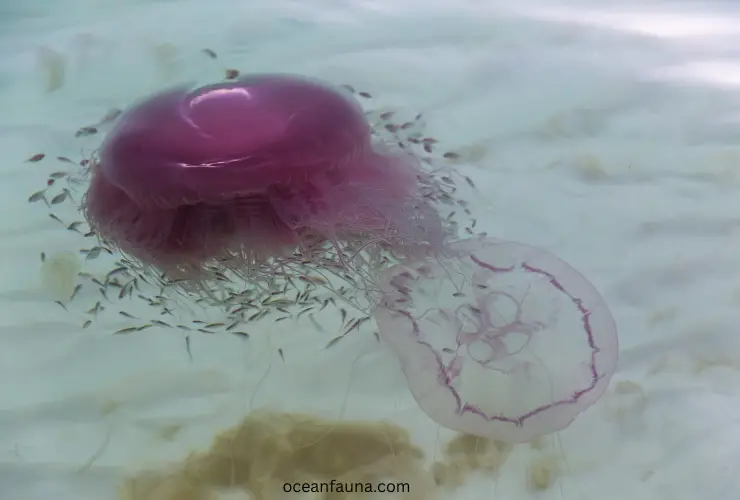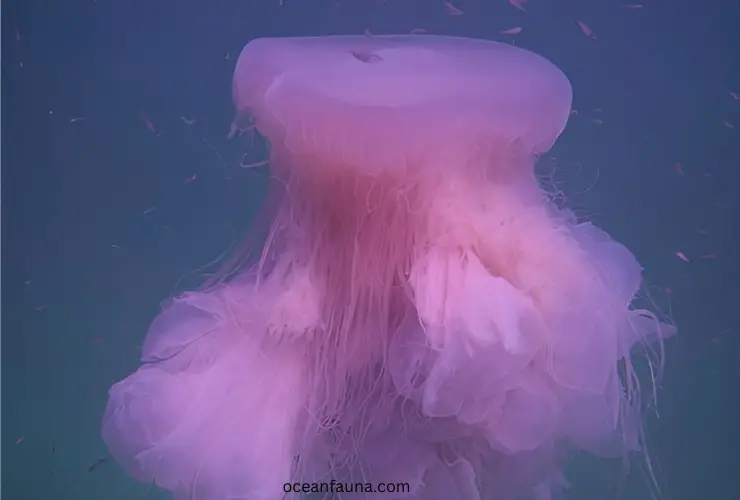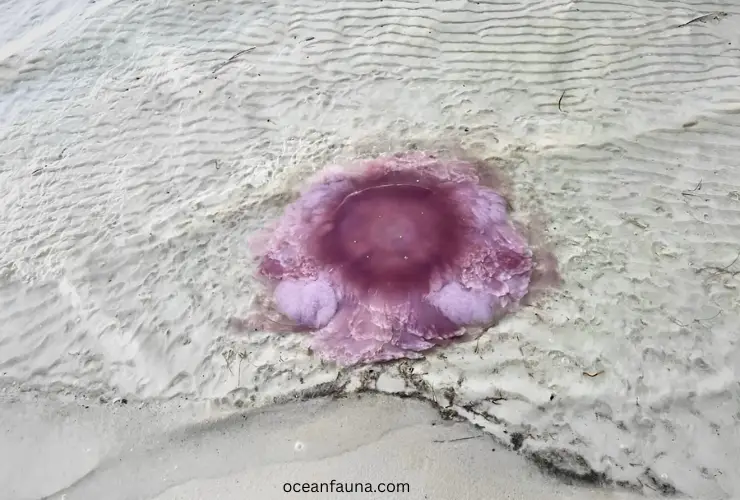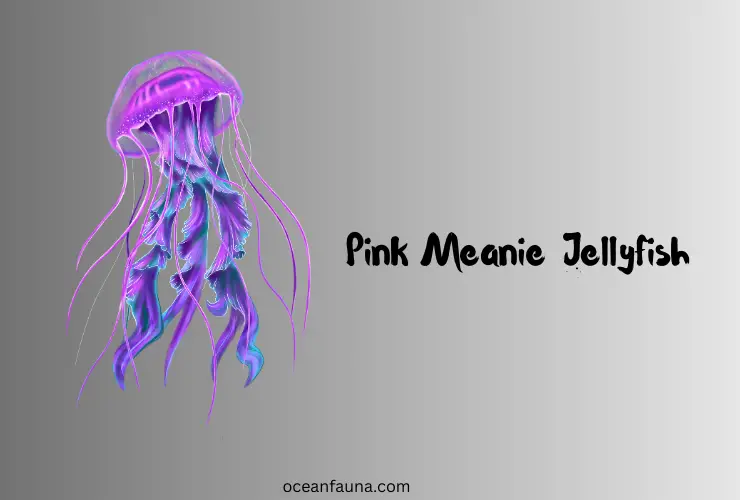Drymonema larsoni is commonly called “Pink Meanie Jellyfish.” They belong to the Scyphozoa class. These sea jellies fall in the order of Semaeostomeae. The pink meanies feed mainly on other sea jellies. They eat the jellyfish species that are in the Aurelia genus.
In 2000, a mass sighting occurred in the Gulf of Mexico. The species and its genus were placed in a new family. This family is now considered a subset of true jellyfish. The unique characteristics of this species warranted its own classification. This event allowed for a better understanding of jellyfish evolution.
Do you want to know the crazy fun facts about the pink meanie? Or do you have a curiosity to know what the pink meanie jellyfish eat? So, get ready to dive deep into the biography of this unique creature.
Whether you are simply curious or a marine enthusiast, this article will pique your interest. Let’s go through it now.
About Pink Meanie Jellyfish – A Quick Biology
Here is a quick biology table about pink meanie jellyfish for your ease!
| Parameters | Details |
| Scientific name | Drymonema larsoni (Bayha & Dawson, 2010) |
| Kingdom | Animalia |
| Family | Drymonematidae |
| Genus | Drymonema |
| Phylum | Cnidaria |
| Class | Scyphozoa |
| Order | Semaeostomeae |
| Species | D. larsoni |
| Habitat | From surface water to deep-depth water |
| Diet | Moon jellyfish |
| The lifeSpan of pink meanie jellyfish | Their lifespan is one year but the exact lifespan is still unknown. However, they die after breeding. |
| Geographical range | Gulf of Mexico and Caribbean |
| Pink Meanie Jellyfish Weight | 14 to 23 kg |
| Pink Meanie Jellyfish Size | Bell height: 56 to 69 cmBell width: 76.2 to 91.4 cmOverall length: 140 to 170 cm |

Some Amazing Facts about Pink Meanie Jellyfish
Here are some amazing fun facts about pink meanie jellyfish:
- Their lifespan depends on prey abundance and ends with cold. For example, they bloom in early fall / late summer when moon jellyfish are found abundantly.
- Pink meanies eat only zooplankton when they are smaller just like other sea jellies. Later on, they develop bodies fit for consuming jellyfish only.
- Their expansive bell offers refuge to baby fish. These baby fish hides them underneath their bells and protect them.
- The pink meanie jellyfish is beneficial for shellfish and fish larvae. It helps them to survive because it eats other jellyfish that eat zooplankton and fish larvae. This is something really optimistic about these sea jellies even though they are creepy sea creatures.
- Bayha and Dr. Graham’s lab collected multiple Drymonema in 2010 and kept them with a lot of moon jellyfish in tanks. This research shows that they can be captive animals. However, captivating a lot of moon jellyfish is also necessary here for their food.
Description And Anatomy of Pink Meanie Jellyfish
Pink meanie jellyfish is a strikingly beautiful species of jellyfish. Their anatomy is similar to other sea jellies. They have a central mouth opening that leads to a digestive system consisting of four radial canals.
The canals transport nutrients throughout the jellyfish’s body. It leads to small, finger-like projections known as marginal lappets. These lappets are believed to play a role in capturing food. These are lined with sensory cells that can detect prey.
The pink meanie jellyfish belongs to the Kingdom Animalia. Its Phylum is Cnidaria and its Class is Scyphozoa. Moreover, its Family is Drymonematidae. Its taxonomic classification places it in the same class as other jellyfish species and in its own family.
The genus name Drymonema refers to the absence of oral arms. It’s a unique characteristic of this jellyfish. Plus, it has a bell-shaped body, which is the main structure of the jellyfish, and it is made up of three layers of cells.
- The innermost layer is the gastrodermis which lines the digestive cavity.
- The outermost layer is the epidermis which covers the entire jellyfish’s surface.
- The mesoglea is the middle layer that separates the other two layers. It provides structure and support for the jellyfish.
Scientists have identified and declared it as an entirely new sea jelly species. So, understanding the anatomy of these sea jellies helps to interact with other species of jellyfish. It is also essential to comprehend our knowledge about how it functions.
Physical Characteristics / Appearance of Pink Meanie Jellyfish
Pink meanie jellyfish have a pink or mauve color with a translucent appearance. Their umbrella-shaped bell can grow up to 70 to 90 cm in diameter. The tentacles of these jellyfish can reach up to 70 feet in length. These are equipped with thousands of stinging cells known as nematocysts.
It relies mainly on its tentacles for catching prey (as we have mentioned before, these sea jellies do not have oral arms). Its striking coloration is a prominent feature that makes it stand out in the marine environment.
Behavior of Pink Meanie Jellyfish
The news article in Sun-Sentinel discusses an unusual and intriguing relationship between a jellyfish and a crab. According to the report, a researcher spotted a small crab catching a ride on the back of a jellyfish in the Gulf of Mexico. The crab was observed carefully balancing itself on the jellyfish as it moved through the water.
The researcher speculated that the crab was likely using the jellyfish as a mode of transportation. It was helpful for the crab to move to new feeding areas or to escape predators. The sighting of this unlikely duo has piqued the interest of scientists. This behavior is common in many other species of jellyfish. (Source)
Another common behavior of a pink meanie jellyfish is swimming. Pink meanies use their umbrella-shaped bells for swimming through the water like other jellyfish. They can move in any direction by contracting and relaxing their bell muscles.
Pink meanie jellyfish are bioluminescent. It means they can produce light through a chemical reaction in their bodies. This helps them to attract prey and communicate with other jellyfish. They can easily be spotted at night due to their low light.
Habitat, Range And Distribution of Pink Meanie Jellyfish
Pink meanie jellyfish are found in the Gulf of Mexico, the Caribbean Sea, and the Atlantic Ocean. They are commonly seen in deeper waters, ranging from 200 to 400 meters deep. However, they have been observed in shallow waters, especially during their juvenile stage.
These are pelagic species. It means that they are found in open water, rather than being associated with the ocean floor. They are also abundantly found in Yucatan Peninsula. They are mostly found in areas where moon jellyfish are abundantly available.
Feeding Habits / Diet of Pink Meanie Jellyfish
According to the Springer research article, pink meanie jellyfish’s primary diet is other jellyfish species. These species usually belong to the Aurelia genus. Hence, pink meanies are helping the ecosystem by controlling the overpopulation of other jellyfish species, especially the Aurelia class sea jellies.
According to this research, the Pink Meanie Jellyfish preys on moon jellyfish. In other words, pink meanie jellyfish have a cannibalistic nature, although they feed on other species; these are jellyfish too. The Pink Meanie Jellyfish can consume large amounts of moon jellyfish in a short time.
They use their long tentacles to capture and subdue their prey. Unlike other jellyfish, they have no oral arms and rely solely on their tentacles for feeding. Their diet primarily consists of small fish, shrimp and plankton.
The pink meanie jellyfish feeding habits impacted the population size of moon jellyfish in the northern Gulf of Mexico in 2000. They take 2 to 7 hours to digest the Aurelia species of jellyfish. Pink meanies reduce the blooms of the Aurelia species. (Source)
According to the explanation of FWC Fish and Wildlife Research Institute, we found this:
“Pink Meanie Jellyfish exhibit voracious feeding behavior on the large groups of moon jellyfish that bloom periodically in the Gulf of Mexico.”
According to American Oceans organization and Marine Biology researchers, they also eat sea walnuts.
Thus, these carnivorous sea jellies play a vital role in the balance of the ecosystem and wildlife. This research sheds light on the unique feeding nature of pink meanie jellyfish in the marine environment.

Life Cycle And Reproduction System of Pink Meanie Jellyfish
According to the National Museum of Research History research, pink meanie jellyfish reproduce sexually and asexually. Its life cycle consists of two different body forms:
- Polyp form
- Medusa form
Polyps are the juvenile form of jellyfish that attach themselves to a surface. It then reproduces asexually through budding. This process involves the polyp growing into a new individual. This individual eventually breaks off from the parent and becomes a free-swimming medusa.
The medusa body form of the Pink Meanie jellyfish reproduces sexually. It happens with the release of eggs and sperm into the water. Fertilization occurs externally here. It results in the formation of a planula larva. This larva will eventually settle on a surface and grow into a polyp. This is how the life cycle continues.
Some pink meanies have the ability to reproduce asexually through a process called strobilation. In this process, the medusa body form splits into several polyps. This allows for rapid reproduction and colonization of new areas. Thus, the life cycle plays a crucial role in the population and distribution of these sea jellies.
Cardiovascular And Nervous System of Pink Meanie Jellyfish
As a jellyfish, a pink meanie’s cardiovascular and nervous system is very simple. Let’s discuss both in separate sections below:
Cardiovascular system
The cardiovascular system is not as advanced as others. It is because they don’t have a heart or a true circulatory system. They rely on the movement of water through their body for gas exchange and nutrient distribution.
Nervous system
The nervous system of a pink meanie is also relatively simple. They have a nerve net that runs throughout their body. It consists of interconnected nerve cells allowing simple reflexes and responses to environmental stimuli.
They also have specialized sensory structures called rhopalia. It contains photoreceptor cells that allow them to detect light and gravity. These structures also contain simple nerve cells that coordinate movement. It helps the jellyfish maintain balance in the water column.
Importance of Pink Meanie Jellyfish in Ecosystem
Pink meanie jellyfish feed on other organisms (moon jellyfish, fish larvae, and zooplankton). Similarly, other marine animals also feed on pink meanies. Sea turtles and some species of jellyfish and fish predate these jellies.
This contributes to the overall biodiversity of the ecosystem. Overall, we can say that pink meanies significantly impact marine life’s functions and health.
Predators of Pink Meanie Jellyfish
Here we are listing a few predators of pink meanie jellyfish:
| Predators | Details |
| Sea turtles | Feed on pink meanie jellyfish, but not a preferred food source |
| Ocean sunfish | Known to feed on jellyfish, including pink meanie |
| Some species of fish | Feed on jellyfish, including pink meanie |
Hammerhead sharks, bluefin tuna, and pelagic crabs are also known as the predators of these sea jellies.
Relationship Between Pink Meanie Jellyfish And Humans
The pink meanie jellyfish does not have a direct relationship with humans. These species of jellyfish are rarely encountered or seen by humans in their natural habitat. However, they can pose an impact on commercial fishing.
They consume other jellyfish that are a good food source for shellfish and fish. More importantly, the pink meanies are an important research subject for scientists. The research is beneficial for other jellyfish species too.

Do Pink Meanie Jellyfish Sting?
Yes. Pink meanie jellyfish sting can hurt you badly. Although their stings are less lethal and not poisonous for humans, their sting can be extremely painful.
According to Wink News, we have found the following fact about its sting: (source)
“Marine biologist Doctor James Douglass has stated that being stung by the Pink Meanie Jellyfish would be less painful than other jellyfish stings. He compared it to feeling like mosquito bites.”
The DISL’s researchers have also found the same fact about their stings: (source)
“They have the ability to get very large in their size as compared to other jellyfish. They can sting with the help of their multiple tentacles. However, Bayha said that these stings are painful but not terrible.”
However, if you are stung by a pink meanie, the best way to treat it is to take Benadryl. These stings could be life-threatening if you are allergic to them or get an allergy after the sting.
Are Pink Meanies Rare?
Yes. Pink meanie jellyfish are rare. These are giant marine creatures but they are not abundantly found all over the world.
According to Wink News, we have come to know the following fact:
“A Naples man found one of the unique and giant jellyfish while walking on Vanderbilt Beach. This was a pink meanie. These Pink Meanie jellyfish are not commonly found in the area where it was discovered, which is the Gulf of Mexico.”
This suggests that the pink meanies may be relatively uncommon. These sea jellies are less frequently observed than other jellyfish species in the region. These jellyfish species are less likely observed in the waters may be due to their predatory behavior as they eat their own kind.
Record of Pink Meanie Jellyfish That Attacks Other Jellyfish
According to news on Rare TV, they have invaded the Emerald Coast by eating the blooms of moon jellyfish. These pink meanies will be attracted whenever there is an influx of moon sea jellies.
Beachgoers were not allowed to visit beaches due to this influx. More than 100 cases of stinging reports from these sea jellies were reported within 40 days. However, these stings were minor, according to the report of Escambia County.
The ‘Facts’ researchers have explained this situation in the following words:
“The Pink Meanie Jellyfish has a unique hunting technique that can be likened to a horror film for other jellyfish. Its long tentacles capture and entangle its prey before consuming them whole. Researchers believe that this jellyfish can consume up to 34 jellyfish at a time.”
The bits of advice from the South Walton Fire District were useful in this situation. They advise wearing SPF to the people. They also said warm water in the affected areas is more useful than ice. These new visitors on beaches are just beautiful outside but creepy inside.
FAQs
Is the pink meanie jellyfish poisonous?
Yes. Pink meanie jellyfish are poisonous. However, their poison is not deadly for humans. But, their stings can hurt you badly and leave you in pain.
How big is the pink meanie jellyfish?
Pink meanie jellyfish can reach n overall length of 140 to 170 centimeters. Their bell width can be 70 to 90 centimeters. Their weight can reach up to 50 pounds. This is how big is the pink meanie jellyfish. Their stinging tentacles can be as long as 70 feet.
Is the pink meanie jellyfish dangerous?
No. Pink meanie jellyfish are not dangerous for humans. They do not kill humans. No evidence is available that it can kill humans and affects them severely.
Conclusion
Pink meanie jellyfish are chaotic, creepy, and stunning at the same time. These marine creatures are just playing their role in the ecosystem. Their beautiful color and unique hunting abilities are worth learning. However, we should discover and learn about these jellies from a distance. The stings of these monstrous jellyfish can hurt you!

